Your Friday Dr. Who Theme Reinterpreted as Belgian Jazz
Graphene Makes Everything Better
Was it a good week for graphene news? It’s always a good week for graphene news! From Graphene-Info:
Researchers from the University of Sussex, the University of Brighton and CNRS have developed a way to wrap emulsion droplets with graphene and other 2D materials by reducing the coatings down to atomically-thin nanosheet layers.
These reflect advancements in a new technology called “liquid electronics,” so new an area there isn’t even a Wikipedia entry for it. Devices made using liquid-based transistors are said to potentially enhance the functionality and sustainability of applications in printed electronics, wearable health monitors, and even batteries. Researchers were also able to create electrically-conducting liquid emulsions that used less graphene—a little graphene goes a long way (as we’re sure you’ll agree).
Another significant development was that the scientists can now make these electronic droplet networks using any liquid – whereas previous research focused on conventional oils and water – because they have discovered how to control which liquid droplets are wrapped in graphene, meaning that they can design the emulsions specifically to the desired application.
Dead or Alive
Meanwhile, inside the box, Schrödinger's cat plans its revenge. pic.twitter.com/cVX9s1BSVM
— Prof. Feynman (@ProfFeynman) February 20, 2022
Get Medieval on You
If we were all suddenly transported back to the Middle Ages (and it could be argued we already have been), one of the first questions that…well, someone would surely ask is, what would company logos look like? Via Laughing Squid, a round-up of artist Ilya Stallone’s rebranding of some famous brands using logos that reflect a Medieval aesthetic.
Logos included the famous Lacoste alligator, the PUMA puma, the original Starbucks logo, and a literal Burger King. Stallone also included modern online entities such as Instagram, Tinder, YouTube, and even Microsoft Windows.
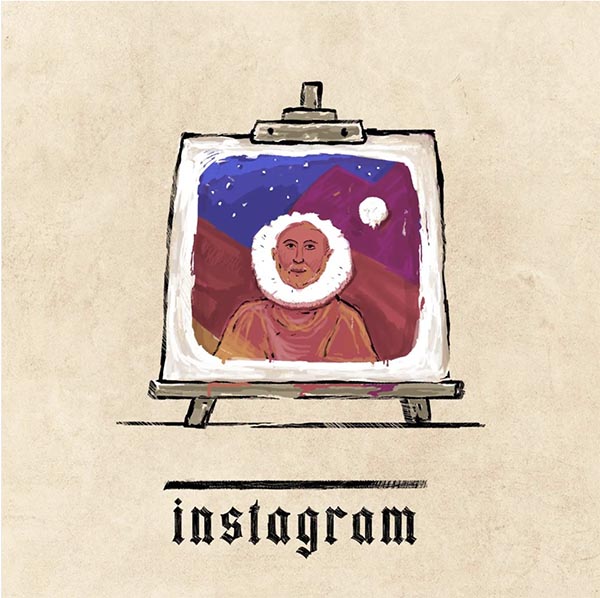
Signs of the Times: Huh?
Writing Puzzle #10.
— Merriam-Webster (@MerriamWebster) February 17, 2022
Rewrite the first sentence for clarity. pic.twitter.com/kiqjT3M24S
Space Shuffle
Well, first we had the Great Resignation—it seemed like everyone was quitting their jobs. Then it was tagged as The Great Upgrade—they weren’t just quitting their jobs, they were leaving for better ones.
Now LinkedIn’s CEO has created a new term: The Great ReShuffle.
[A]n unprecedented moment in the history of work where all of us are rethinking not just how we work, but why we work. To me, this is a great thing. More people will be doing work they love at companies they feel passionate about, leading to greater success for organizations who engage their employees with empathy and trust.
Well, and of course, what are they (largely) using to find those jobs? LinkedIn.
Honestly, these terms all describe pretty much the same thing. Perhaps the big rush is to create new hashtags!
Nietzsche’s Way
What doesn’t kill you makes you scared of that thing.
— (((Joshua Malina))) (@JoshMalina) March 19, 2021
what does not kill me makes me stronger, like it's toying with me
— blaine capatch (@blainecapatch) February 22, 2022
My Man!
Wait…an actual, physical picture? Not an NFT? How old school. From CNN:
Man Ray's famed "Le Violon d'Ingres" is poised to make history as the most expensive photograph ever sold at auction.
The black and white image, taken in 1924 by the American surrealist artist, transforms a woman's naked body into a violin by overlaying the picture of her back with f-holes.
The original print of the masterpiece, widely considered to be Man Ray's most famous work, is expected to fetch between $5-7 million when it goes under the hammer at Christie's in May -- the highest estimate for a single photograph in auction history, according to the auction house.
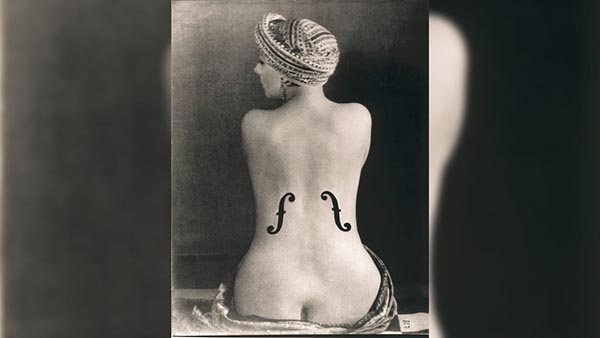
Alamy
Monkey Business
I had just replaced my stolen apes with new apes and now they, the second apes, have been stolen too. Time to get third apes. https://t.co/rbcPaZrTPN
— Bill Corbett (@BillCorbett) February 20, 2022
Domo Arigato
You may recall that back in the early 2010s, Google, in response to Apple’s design-centric approach to technology, introduced its own typeface for Android 4.0. Called Roboto, it was a neo-grotesk sans serif face that was called a “frankenfont” by typography purists, as it seemed to be kludged together from other typefaces. All these years later, Google has complemented Roboto with Roboto Serif. Says The Verge:
The new font isn’t just the old Roboto letters with some serifs slapped on, though: rather, each letter was redrawn from scratch to create a font that “thinks about Roboto, but is a new and original design,” according to Google UX manager Rob Giampietro. The new font still uses the same vertical proportions of Roboto Sans, making it possible to mix the serif and sans-serif versions in a single design.
Pen Is Mightier
I saw this in CVS today and bought it. Because I thought it was 1979. pic.twitter.com/kQKuAV4Cla
— ChrisTopher (@va_cc11) February 17, 2022
Better 1…Or Better 2…
Now, here’s an idea… About 14 years ago, Oxford professor Joshua Silver floated (as it were) the idea of a pair of water-filled self-adjusting glasses that could change prescription on-the-fly, eliminating the need for opticians. A pair of water-filled syringes mounted on the sides of the glasses filled the lenses. The wearer could adjust the amount of water in each lens until they could see clearly.
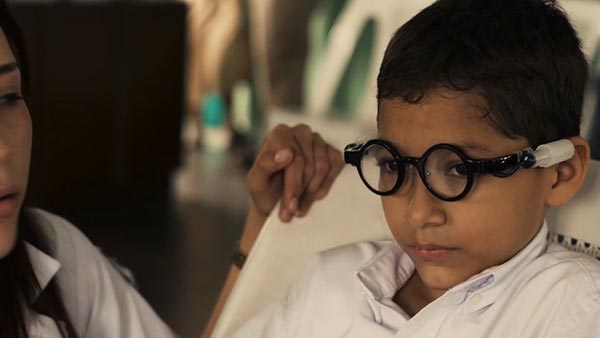
They were designed as a low-cost, low-tech way to improve the vision of people, especially children, in developing countries. And in fact they did (and still do) just that:
[an] organization called the Centre for Vision in the Developing World…has provided 100,000 pairs of his adaptive glasses to people in over 30 countries. They reckon they will have to multiply that a bit, as "More than 2 billion people in the world today need glasses but don't have them." They also cite that "100 million school-aged children cannot read the blackboard in class."
So, well done!
Fast forward 14 years and University of Utah professor Carlos Mastrangelo has sexed up this idea and made it more high-tech. Says Core77:
Mastrangelo's design uses piezoelectric tunable glycerin-filled lenses. To start with, the user enters their prescription into an app that communicates with the glasses. The glasses then automatically dial in the prescription. The kicker is that there's some kind of distance sensor that supposedly continues to adjust the prescription in real time, depending on the distance of what you're looking at. "This information is provided by a sensor mounted in the bridge of the glasses that uses pulses of infrared light to identify where the user is looking and provide the precise distance," according to Mastrangelo's research team.
“Theoretically, these would be the only glasses a person would ever have to buy because they can correct the majority of focusing problems,” says Mastrangelo.

Do they come with different frames?
Great Moments in Correlation vs. Causation
Coincidence? pic.twitter.com/jvXdPCV8vP
— Michael Kofi A.||?????(@MikeKofiA) February 20, 2022
The Cause That Refreshes
Via Core77, some bad and good news for the Coca-Cola company. First of all, “According to a Global Brand Audit report from last year, ‘The Coca-Cola Company is the world’s worst corporate plastic polluter for the fourth year in a row.’”
Some of us remember a time before plastic bottles when Coke did indeed come in refillable glass bottles. Not only was it less polluting, but it also gave the act of drinking soda a bit more dignity as well. As it turns out, Coke actually has a refillable bottle program—in Brazil. According to Packaging Europe, this works thusly:
Customers pay an indirect deposit when purchasing soda in a refillable bottle by receiving a discount on their next purchase when they return the empty bottle to the store – a reward feature that reportedly ensures a return rate of above 90%. The company argues that this feature also creates a strong attachment to the brand, as well as an increased likelihood of repurchase.
Retailers then store the empty bottles and give them back to Coca-Cola upon delivery of a new order. Next, Coca-Cola brings the multi-branded mix of bottles back to a bottling facility where paper labels are washed off and bottles are cleaned, refilled, and rebranded with a fresh label before being redistributed.
To answer the first question you might have:
The bottles apparently last up to 25 cycles and are recycled at the end of their useful lives, along with their 100% recyclable labels.
The company says that creating a universal bottle design across all brands significantly reduces washing, filling, and costs in terms of reverse logistics, while at the same time lowering carbon emissions. The reusable model reportedly replaces 200 million single-use bottles per year in Brazil and was Coca-Cola's fastest-growing packaging format in 2018 in Latin America.
Nice idea, but as Core77 points out, Coke isn’t even all that dedicated to it: “This month Coke has responded by announcing a goal of increasing their sale of refillable bottles from 16% now to 25% in 2030.”
Given that by 2030 probably one-third of the Pacific Ocean will comprise a swirling gyre of discarded face masks and sanitary wipes, we should reduce the volume of discarded plastic bottles to make room.
All Maps Amazing and Terrible, Part the Infinity
There's a straight line between Liberia and China that stretches 13,500km without crossing any ocean or major body of water #Liberia #China #Maps #Map #Amazingmap #Amazingmaps pic.twitter.com/6QjC1DXDx3
— Amazing Maps™ (@amazingmap) June 10, 2020
Egypt is smaller than the United States, Russia and China combined pic.twitter.com/l7SKYY5375
— Terrible Maps (@TerribleMaps) October 9, 2021
Beam Right There
Is this that college sports transfer portal we’ve heard so much about?
Not, really, no. What it is is a system developed by PORTL that “lets people virtually beam interactive 3D holograms of themselves and/or objects across long distances…. The full spectrum imagery also allows for greater detailed visuals in work, learning, and medical settings, possibly replacing video calls in the future.” Sounds like Zoom: The Next Generation. At the moment, there are two models: the tabletop PORTL-M and the human-sized Epic.
Claim Your Stake
That moment at the flea market, when you realize you're looking at a vampire killing kit. pic.twitter.com/ktwuDGFX6q
— John Moffitt ???????? (@JohnRMoffitt) February 18, 2022
Are You Being Robo Served?
We have written in this space a few times about the gradual proliferation of robot restaurants. (That is, restaurants run by robots, not restaurants for robots, although we suspect those are not far off.) Core77 updates us on some unique ideas for expanding the roles of robots in restaurants. (OK, the alliteration is getting annoying even for us!) There is Servi, sort of like R2D2 in Jabba the Hutt’s pleasure barge in Return of the Jedi, currently trundling about restaurants in L.A.
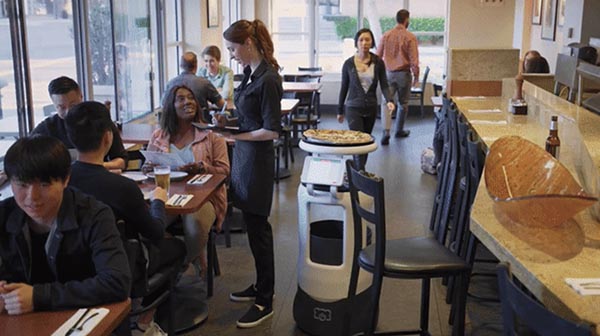
In South Korea, a café called Storant is implementing its own Automated Café Server Robot, which uses the same basic R2D2-like design—and for good reason, as Core77 points out: “these things need to be friendly-looking, have rounded edges in case someone walks into one, and be table height for seated customers to grab items off of.”
They also have an idea:
It would be funny if some restauranteur decided to do away with tables altogether, and replace them with the 'bots themselves. Both Servi and the ACSR aren't much smaller than some café tables I've seen; what's needed is a tabletop wide enough to provide legroom beneath, and I propose that the 'bots be capped with automated Fletcher Capstan tops:

As a former server myself, I can tell you we were always under pressure from management to cycle customers out as quickly as possible. Table 'Bots would do a great job of this: As soon as the meal's finished, the table folds itself up and disappears into the kitchen, leaving four people sitting in an awkward circle with nothing between them, like a tiny support group. I guarantee they'd leave quickly.
Morning Joe
That moment when you go to install a new coffee maker, start to read the fifty thousand pages of instructions, and realize to your horror that there's no way in hell you can handle this without coffee.
— J. Michael Straczynski (@straczynski) February 17, 2022
And the world, and everything in it, freezes.
We Have Reservations
OK, we just had a look at robot restaurants. But now, are you ready to check into the world’s first robot-run hotel? You can check out any time, but…well, you know. Says Boing Boing:
Japan has always led the charge when it comes to technological innovation. Now it seems as if they're venturing to take the concept into the service industry. You get a brief glimpse at the Japanese Henn na Hotel Tokyo Ginza in the post. Staffed entirely by artificial intelligence, Henn na Hotel Tokyo Ginza is the World's first robot hotel.
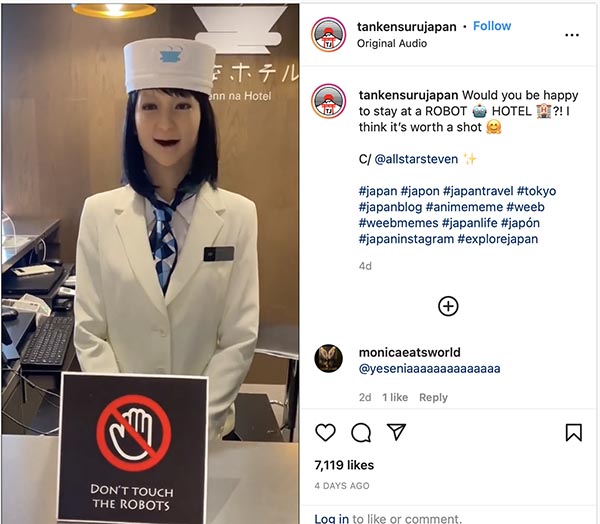
To be honest, the Bates Motel was less creepy.
Ticket to Ride
That's why I only do it on special occasions. https://t.co/x2UT54WUq9
— J. Elvis Weinstein (@JElvisWeinstein) February 22, 2022
Luxury Cruise
There is been a tremendous push in recent years for the adoption electric vehicles, and for good reason. However, current EVs have one major drawback, perhaps best exemplified by an incident that occurred this week. Says The Guardian:
An abandoned ship that caught fire in the mid-Atlantic last week was carrying $401m (£295m) worth of cars, including Porsche, Audi, Bentley and Lamborghini models, an insurance estimate has revealed.
Felicity Ace, a specialist cargo ship carrying more than 4,000 cars, caught alight near the Azores on Wednesday evening. The vessel’s 22 crew members were evacuated but the fire continued to burn for several days, fuelled by lithium-ion batteries in electric vehicles on board.
The batteries used in EVs do present problems if there are accidents. We have heard some using this as an excuse to forget all about EVs and that phasing out gas-powered vehicles is a bad idea. Sure, every technology has a downside, but this and other problems will be addressed as the technology develops and batteries improve.
Kind of Like Poetic Justice
Fake cheating sites are the latest risk for remote students https://t.co/GI73YOWZYH pic.twitter.com/j1uneDQWDN
— The Verge (@verge) February 16, 2022
Mr. Limpet Gets More Incredible
This is a headline to conjure with. From Gizmodo: “Scientists Created a Cyborg Fish Powered by Beating Human Heart Cells.” Why would they do this, since proper fish work perfectly fine? Actually, a robotic fish was not the end game: “researchers at Harvard and Emory University are using it as the groundwork towards growing organic artificial hearts one day.”
The fish’s design features a flexible tail that’s covered in a layer of heart muscle cells (cardiomyocytes derived from stem cells) on each side. When the cells on one side contract, it pulls the tail in that direction, and when the cells on the other side contract, it pulls the tail in the opposite direction. But what’s particularly interesting about this biohybrid is that the two layers of muscle cells are continuously triggering each other. When one side contracts, it causes the other side to stretch, and the stretching action opens a “mechanosensitive protein channel” that causes that side to contract, which in turn stretches the other side, and the process repeats.
It’s Good to Be the Queen
Olivia Colman is about to join Star Wars or the Supreme Court pic.twitter.com/W3Pl8srAeC
— Erik Anderson (@awards_watch) February 18, 2022
This Week in Printing, Publishing, and Media History
February 21
1804: The first self-propelling steam locomotive makes its outing at the Pen-y-Darren Ironworks in Wales.
1821: American publisher and founder of Charles Scribner’s Sons Charles Scribner I born.
1828: Initial issue of the Cherokee Phoenix is the first periodical to use the Cherokee syllabary invented by Sequoyah.
1842: John Greenough is granted the first U.S. patent for the sewing machine.
1848: Karl Marx and Friedrich Engels publish The Communist Manifesto.
1874: The Oakland Daily Tribune publishes its first edition.
1878: The first telephone directory is issued in New Haven, Conn.
1903: French-American essayist and memoirist Anaïs Nin born.
1925: The New Yorker publishes its first issue.
1947: In New York City, Edwin Land demonstrates the first “instant camera,” the Polaroid Land Camera, to a meeting of the Optical Society of America.
1958: The CND symbol, aka peace symbol, commissioned by the Direct Action Committee in protest against the Atomic Weapons Research Establishment, is designed and completed by Gerald Holtom.
1962: American novelist, short story writer, and essayist David Foster Wallace born.
1967: American author and screenwriter Charles Beaumont dies (b. 1929).
February 22
1632: Galileo’s Dialogue Concerning the Two Chief World Systems is published.
1857: German physicist, philosopher, and academic Heinrich Hertz born.
1878: In Utica, N.Y., Frank Woolworth opens the first of many of five-and-dime Woolworth stores.
1924: U.S. President Calvin Coolidge becomes the first President to deliver a radio address from the White House. We bet it was riveting.
1925: American illustrator and poet Edward Gorey.
1983: The notorious Broadway flop Moose Murders opens and closes on the same night at the Eugene O’Neill Theatre.
Today is 2-22-22. That will not happen again for ONE HUNDRED YEARS. Tomorrow will be 2-23-22. That will not happen again for ONE HUNDRED YEARS.
— (((Joshua Malina))) (@JoshMalina) February 22, 2022
February 23
1455: Traditional date for the publication of the Gutenberg Bible, the first Western book printed with movable type.
1633: English diarist and politician Samuel Pepys born.
1821: English poet John Keats dies (b. 1795).
1898: Émile Zola is imprisoned in France after writing J’Accuse…!, a letter accusing the French government of antisemitism and wrongfully imprisoning Captain Alfred Dreyfus.
1904: American journalist and historian William L. Shirer born.
1927; U.S. President Calvin Coolidge signs a bill by Congress establishing the Federal Radio Commission (later replaced by the Federal Communications Commission) which was to regulate the use of radio frequencies in the United States.
February 24
1582: With the papal bull Inter gravissimas, Pope Gregory XIII announces the Gregorian calendar.
1607: L’Orfeo by Claudio Monteverdi, one of the first works recognized as an opera, receives its première performance.
1711: The London première of Rinaldo by George Frideric Handel, the first Italian opera written for the London stage.
1854: A Penny Red with perforations was the first perforated postage stamp to be officially issued for distribution.
1921: American actor Abe Vigoda born.
1955: American businessman and co-founder of Apple Inc. and Pixar Steve Jobs born.
1968: American comedian and actor Mitch Hedberg born.
1989: Ayatollah Ruhollah Khomeini issues a fatwa and offers a USD $3 million bounty for the death of Salman Rushdie, author of The Satanic Verses.
February 25
1644: English pastor, engineer, and inventor of the first practical steam engine Thomas Newcomen born.
1899: German-English journalist and businessman, founder of Reuters Paul Reuter dies (b. 1816).
1928: Charles Jenkins Laboratories of Washington, D.C. becomes the first holder of a broadcast license for television from the Federal Radio Commission.
1943: English singer-songwriter, guitarist, and producer George Harrison born.
1983: American playwright, and poet Tennessee Williams dies (b. 1911).
February 26
1564: English playwright, poet, and translator Christopher Marlowe born.
1616: Galileo Galilei is formally banned by the Roman Catholic Church from teaching or defending the view that the earth orbits the sun.
1802: French author, poet, and playwright Victor Hugo born. (We had a hunch.)
1909: Kinemacolor, the first successful color motion picture process, is first shown to the general public at the Palace Theatre in London.
1918: American author and critic Theodore Sturgeon born. (It was an amok time.)
February 27
1691; English publisher, founder of The Gentleman’s Magazine Edward Cave born.
1807: American poet and educator Henry Wadsworth Longfellow born.
1812: Poet Lord Byron gives his first address as a member of the House of Lords, in defense of Luddite violence against Industrialism in his home county of Nottinghamshire.
1891: American businessman and founder of RCA David Sarnoff born.
1902: American journalist, author, and Nobel Prize laureate John Steinbeck born.














